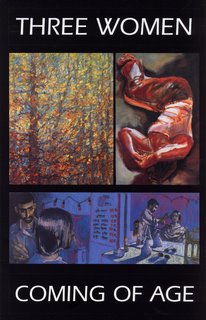An art critique as well as exhibition preview and overview archive spanning from 1999 to 2012 by Mary Lee Pappas, the art critic for the alternative weekly newspaper, NUVO, and visual arts columnist for the daily paper, The Indianapolis Star. Indianapolis, Indiana.
Ad
Thursday, July 26, 2001
"The Female Persona" Jack Hartigan and Michelle Pemberton - Easter Conservation Services - July 26, 2001 - 2 1/2 stars
Pemberton's "Mother's Little Helper" series, cramped in the gilding and frame restoration dream haven, is hysterical. The 1950's Betty Crocker housewife ideal is parodied in these staged stark black and white shots with high camp props and a modern look. A model, cigarette dangling from her lip, in one shot looks like a haggard moping mess ready to get gooped up for the prom - she also looks as if she's about to bust with laughter at this scenario she's in. Lucky Strikes are tucked into the huge lace-banded nylon panties of a bored Valium-popping model primping for a big night she's obviously somewhat chagrined about. Add the McCall's, prissy wallpaper, train cases and rollers and you've got a charming mythical mockery of 1950's dress-up. The "Seasons" series is soft with tea-stained tones. The overlapping dreamy images of a bouquet-headed beauty look like architectural stone embellishments. Hartigan's photos of centerfolds defaced on the wall of a downtown building, are really graceful, but boring sociological surveys. The textured, spoiled remnants of bombshell babe bedroom shots simply appear as simplistic abstract indiscernible swaps in these large pieces well juxtaposed with Pemberton's work. Through July 27, 2001. 317-507-4701. - Mary Lee Pappas
Casey Cronin and Craig McCormick - Efroymson Gallery at the Harrison Center for the Arts* - July 26, 2001 - 3 1/2 stars

Abstract expressionism and post modernism through photography is brilliantly achieved in McCormick's work. His truly innovative images are shot through cardboard masks, and then further manipulated in the darkroom into subtle cubist renderings. Broken images of urban landscapes, sublimely colored, represent brief periods of time instead of singular split seconds typically seen in photos. Crises in his landscapes erupts, evolving in much the same way modernism did in painting. Reality is torn apart to create an illusion of the image (and the cars and things within the images) and of deep space. Technically, Cronin's work is pristine. Straightforward black and white untitled shots (mix and matchable) from European travels are artistically journalistic and rich with tone variance and a mausoleum silence. They are lonely and intimately bland. "The Laocoon Group," a full-round revolutionary Hellenistic sculpture at the Vatican Museum, is ironically photographed with some sculpture imagery negated from the cropped composition. The celebrated sculpture is spliced into a 2D isolated study. The range of grey tone beautifully defines the agony and realism of the ancient piece. Unfortunately, photo locations were not given and the architectural and sculptural subjects photographed were not named. The photos were dizzyingly displayed. They weren't hung in a coherent fashion and lost their impact split apart. Through August 31, 2001. 317-951-9610.- Mary Lee Pappas
*The Efroymson Gallery is currently the Harrison Center for the Arts Gallery at the Harrison Center for the Arts.
Saturday, July 21, 2001
Frank Glover - Durwyn Smedley's - July 21, 2001 - 3 stars
Closed July 4.
The "Window series," four acrylic on paper energetic astracts by local jazz clarinet great Frank Glover, hang clumsily by clear plastic pushpins in a little corner under two distracting shelves and above some antique knick knacks. Local galleries should be vying to represent this multitalented artist. His work complements and is a colorful and quiet einb-~diment of his music. The influence of his friend, local master Lois Templeton, obvious. Their art style, smooth suriz~ces ai)d colors, is strikingly alike. Cool golden and dirty blue hues are scratched with black charcoal into unintelligible scribble script. The improvisational motions evoke a feeling of quietioie de vivre and soul. This venue is not appropriate for such beautiful work. -Mary Lee Pappas
Connie Zeigler resources Indianapolis historic my Indiana home polis center monthly
Thursday, July 19, 2001
J. David Smith - Munce Art Center - July 19, 2001 - 3 stars

Smith, associate dean of development for the Indiana School of Medicine, takes quality black and white photographs. His artist's statement says that he is inspired by "the ever changing forms and arrangements" of nature which are dissected
artistically by his camera. Local artists take note: This novice wrote a kick-butt, eloquent, well-written and understandable artist's statement. The series of photos on exhibit were all snapped during one walk in Zionsville after a memorably wicked snowstorm in 2000 - the cold miser undoubtedly being Smith's muse. The grandeur of neglected, tiny, fleeting beauty in nature takes center stage in tight compositions that make Mother Nature a Dada disciple. Ice and compacted fallen snow create natural artistic abstractions in "Ice Crystal," "Spider Ice" and "Holy Wall." There is nothing experimental or out of the ordinary with Smith's approach or technique. If I had to guess, I'd say he shot these with a trusty old Pentax K 1000. All of the shots are sharp, frozen, and perfectly exposed with studious exactitude - so much so that the f-stops and shutter speeds for each image could probably surmised as well. It is the care and honesty with which he captures his observations that make his photographs memorable. Through July 28, 2001. 317-873-6862. - Mary Lee Pappas
"Homecoming" Chip Henderson - J.Martin Gallery - July 19, 2001- 3 1/2 stars

Henderson throws narrative art out the window while bulldozing function for form in these mostly large monotone, smooth abstract, atmospheric works. They are musings of mood ripe with Zen and void of visual aversions. Far from being desolate, these subltely striped works evoke contemplative stillness with candlelight translucence. At a glance, the work of Rothko comes to mind, then vanishes upon inspection. These works are delicate. Sheer, careful rows of thinned oil make the canvases appear to be vellum. The dark crimson colors of the painting, "400 Miles," for instance, are formed and manipulated in a series of glassy layers that envelope each other like memories and shadows of our subconscious. The transparency of the paint is pushed and challenged by the infinate density of deep tones. Involuntary meditative participation is bound to occur while viewing these subliminal landscapes. Japanese paper and wax are the vehicles for earth-hued pigment in several pieces including "Hairshirt," the signature piece of the show. Through July 31, 2001; 317-916-2874. - Mary Lee Pappas
Thursday, July 12, 2001
"Sports Heroes - Two Views" James Fiorentino and Elizabeth Yorgen - National Museum of Art and Sport - July 12, 2001 - 2 stars

Thirteen true-to-life head and shoulders sports portraits by the mega accomplished James Fiorentino (23 years old) leave little to the imagination unless you are a student of watercolor. Executed deftly in watercolor, they are amazingly photo realistic and beyond perfect technically. You can see every hair on Cal Ripkin Jr.ís arm. Skin tones are rich and real, proportions are so anatomically faultless that it's no wonder Fiorentino was admitted into the New York Society of Illustrators at the tender age of 19. Images from the 1999 Topps Heritage Baseball Card series he created are on view also. In a big-time contrast are "Temple Games," four mixed media sculpture/conceptual works by Elizabeth Yorgen. Oozing glue gun goo, they comically portray basketball, hockey, baseball and football stars as "idolized in a very similar manner to the way that athletes were idolized in ancient Greece," an artists statement reads. It then makes a parallel to the Temple of Zeus in Olympia where these said athletes are were actually lapiths and the centaurs. Each piece has three humbly painted panels of athletes paired off in physical struggles (tackles and dribbles) flanked by four crude sets of wood colonnades. Could these athletes blasphemously be playing in the bastardized pronaos? Like friezes of the Classical Severe style, the scenes are dramatic, compact, and simple. A paint by numbers primary color scheme prevails as does a coloring book composition. Colors stay inside the lines with model plane precision. The pediments carry modern arena imagery flanked by 3D playing utensils: hockey puck, toy basketball hoop, you get the idea, etc. Through August 12, 2001. 317-274-3627. - Mary Lee Pappas
"Three Women Coming of Age" Patrica Rhoden Bartels, Caroline M. Mecklin, Maureen O'Hara - Hoosier Salon - July 12, 2001 - 4 stars

Patricia Rhoden (Bartels), Caroline M. Mecklin and Maureen O'Hara Pesta are three accomplished phenom female Indiana artists. Great impasto strokes of sunshine-enhanced color tease and delight the optic nerve in Rhoden-Bartels' impressionistic Indiana landscapes. The groundless compositions immerse you in dreamy, vibrant, fresh air moments full of wind and lively light. You fly through her distinctive paintings. Her work redefines Indiana art history and is nothing short of spectacular. Mecklin's prolific portraits of her beautiful daughter Libby are seductively silent and utterly feminine. Demure female forms are defined by their confident placidity - they are as much about the splendor of the female body as they are about female assurance within that body. Sweeps and streaks of sporadic and calculated colors combine to create contemporary pseudo odalisques from untraditional perspectives. Pesta's work is very poised. Her approach is less distorted and without the realistic excess or untrue vantages. Quiescent scenes are set and stories told through the precision in her exacting pastel lines. Through July 28, 2001. www.hoosiersalon.org. 317-253-5340. - Mary Lee Pappas
Christina Roberts and Lisa Pelo-McNiece - Art in Hand Gallery - July 12, 2001 -
Closed June 30, Christina Roberts' stained glass work was nowhere to be found. Pelo-McNiece's mouth-blown glasswork was at the gallery, as publicized, and radiantly diverse while consistent in its technical excellence. Two lavender and blue iridescent pieces, dabbled with grassy green flecks, sat perfectly in the window of the c.0-op gallery, their twists and shapes looking sculpted from clay. Most intriguing was a piece that was streaked with deep cherry red and formed with thin copper wire. It had the appearance of a heart with a molten 1,.va volcano top starting to erupi. Liberal use of color powder in her glass created delicate fibrous, granular and ribbed texture patterns. Four individual petite sphere vases glowed-with solid lerhon yellow. - Mary Lee Pappas
Bam Miller - Indianapolis Artsgarden - July 12, 2001 -
Bam Miller's black pen dravvings on flimsy, stark white paper, mattec and covered in what looked like saran wrap taped together on the back, could have used a littleTLC. I readily recognized th illustrative black squiggle line portrait of drummer Jack Gilfay. 'Jimmy Goes to Mai-ket,' of Jimmy Coe, and "Four Other Brothers" were the best drawings in thebunch but that's not saying much. The pieces were stff, flat, fundamental and none. pressive, Jost in their poor presentation. Considering our city recently introduced a $10 million arts initiative, I would expect extra oomph in the level of professionalism demonstrated within the Artsgarden. The AG should have done something to a sist, improve and enhance the presentation of Miller's illustrative work. Do we want to represent the arts in Indianapolis in Such a dismissive way to the throngs of visitors traipsing through the mall? Indianapolis is all aboutjazz in July, so Miller a ac- tion portraits ofiazz musicians are absolutely apropos foe the season. But what'sthe point ~ the show is executed without care? Through July 16; 631-3301. -Mary Lee Pappas
Subscribe to:
Comments (Atom)